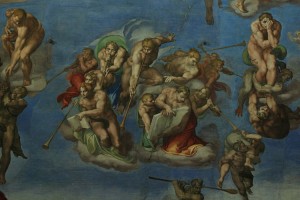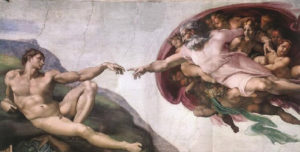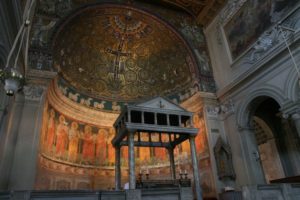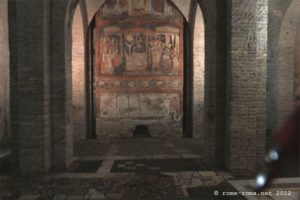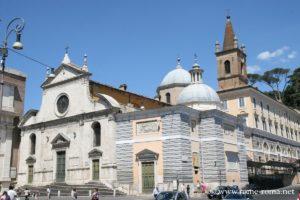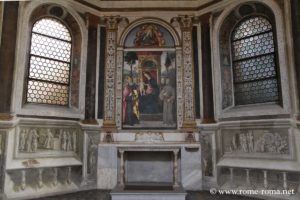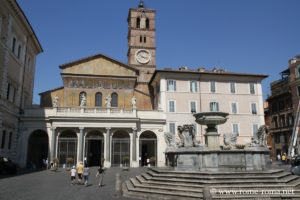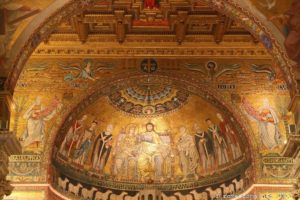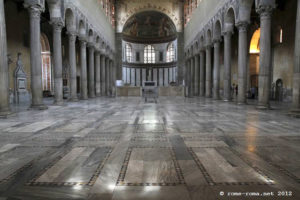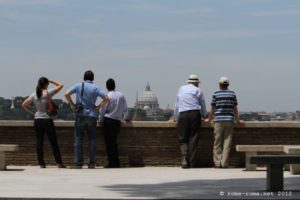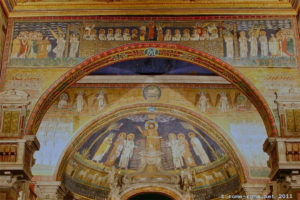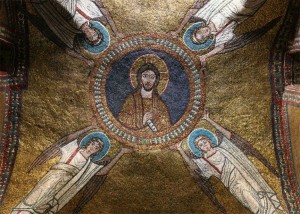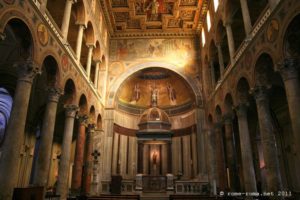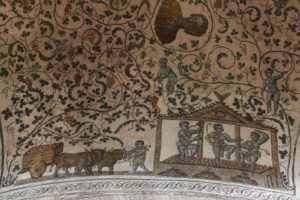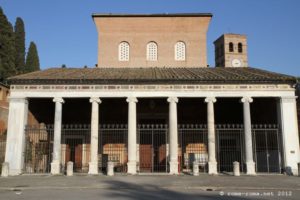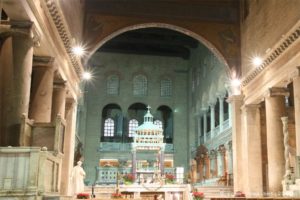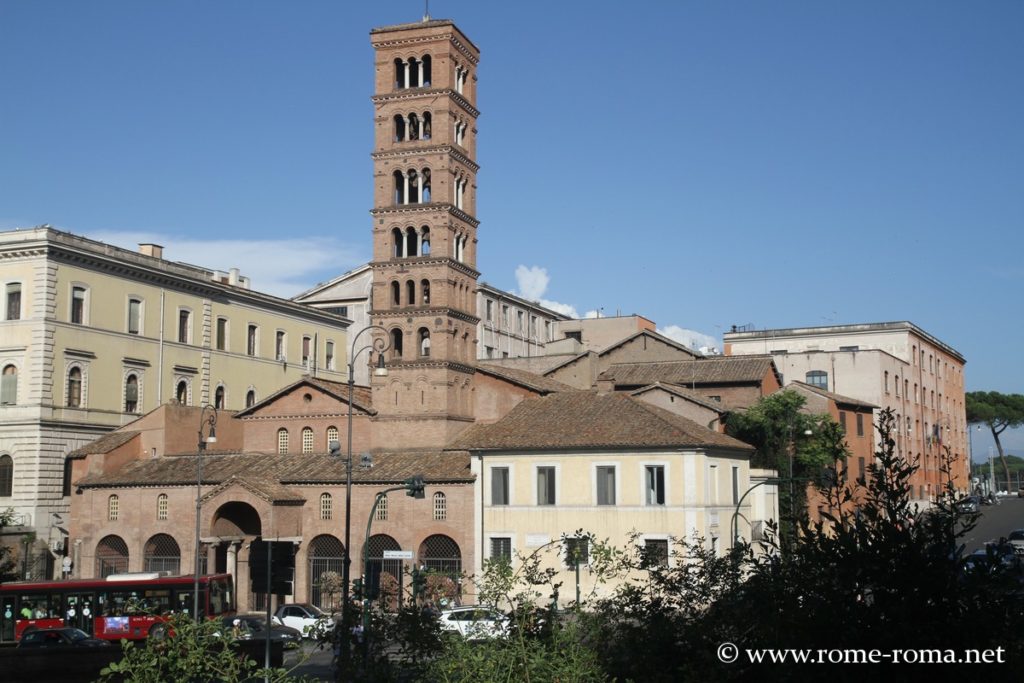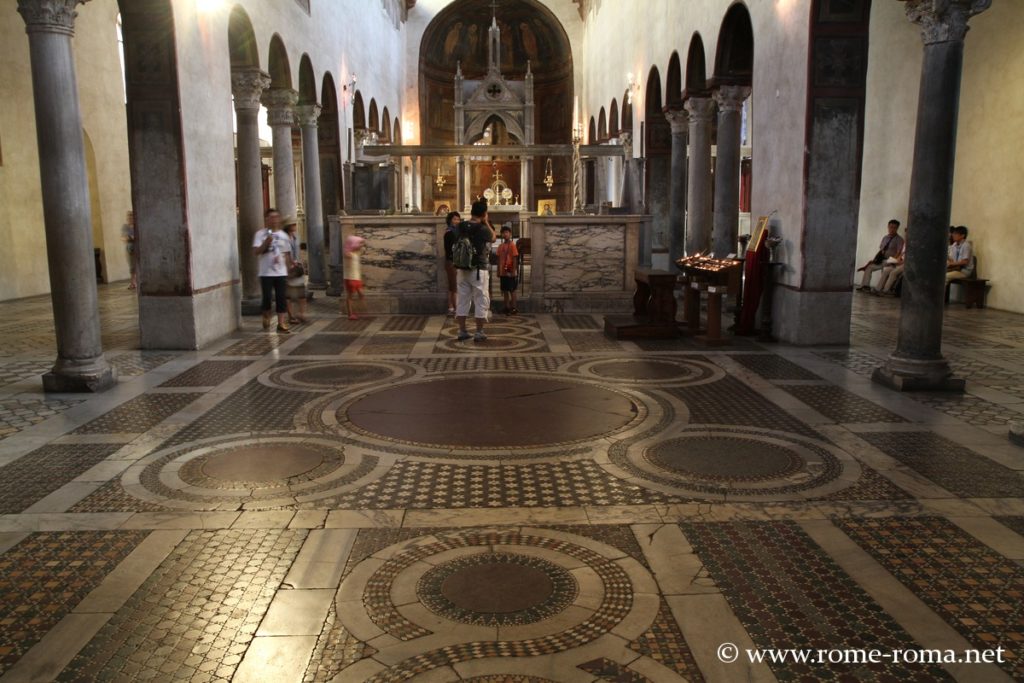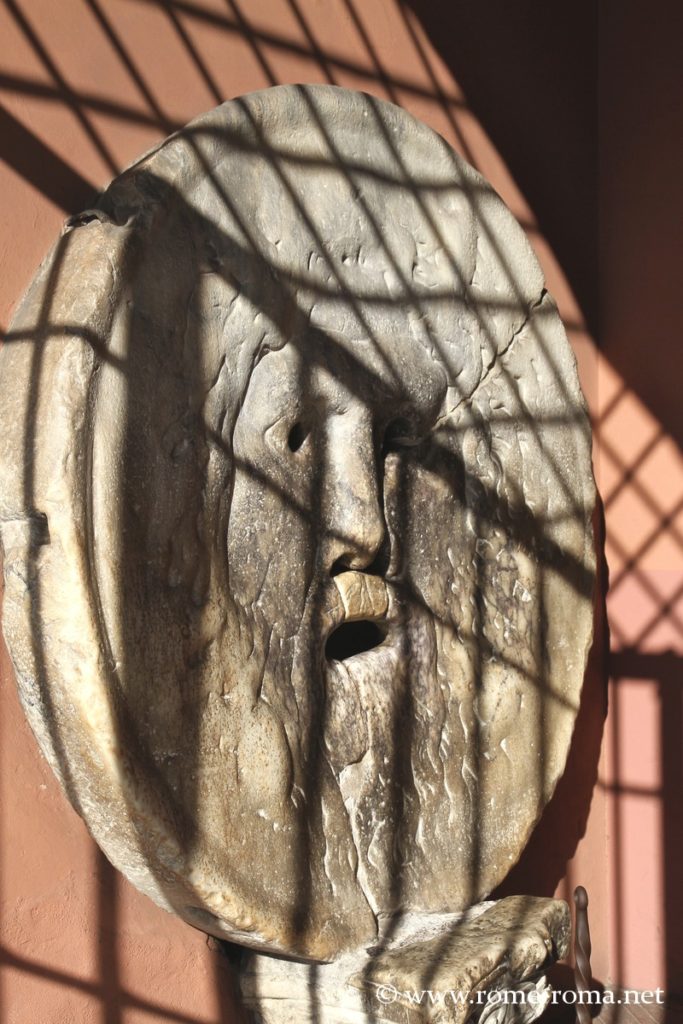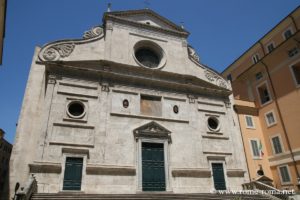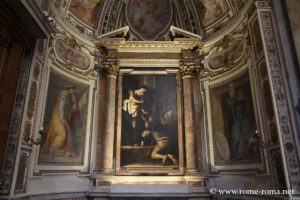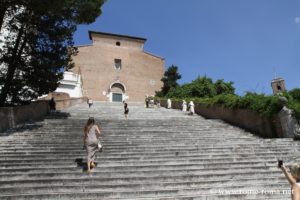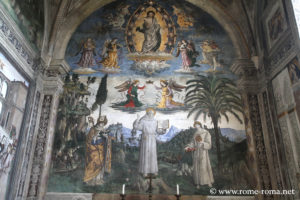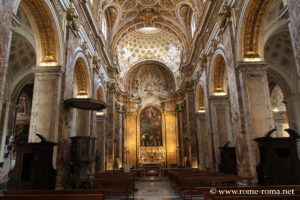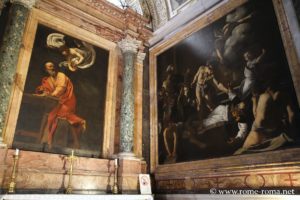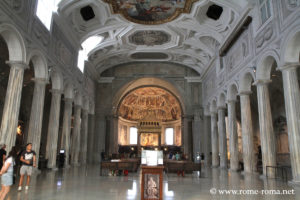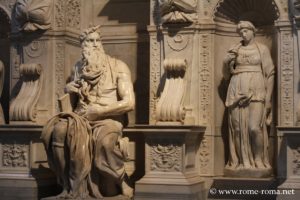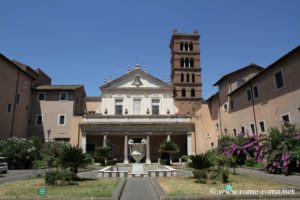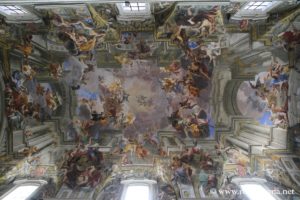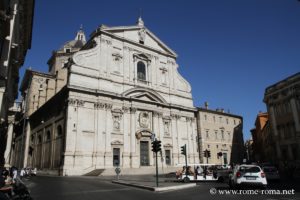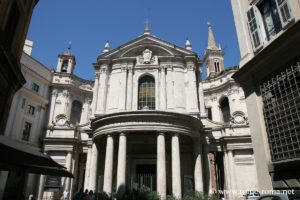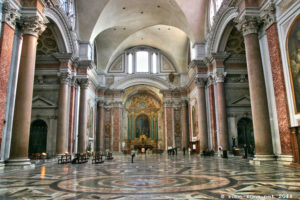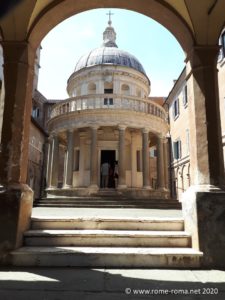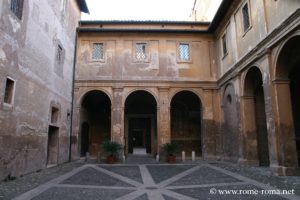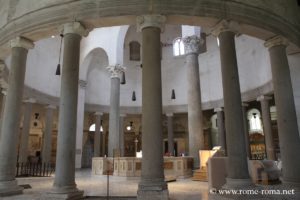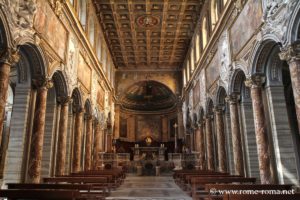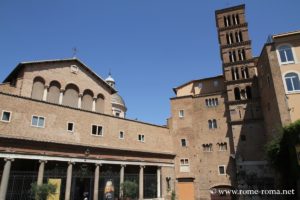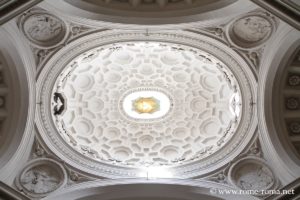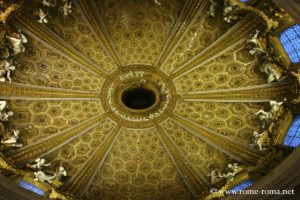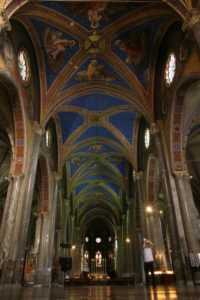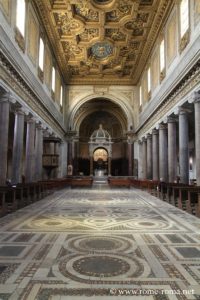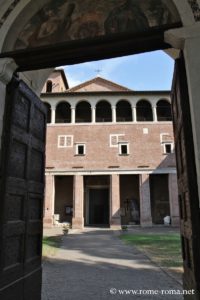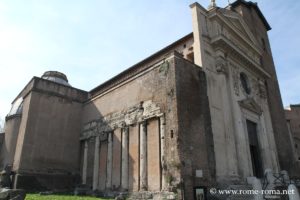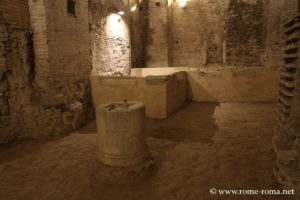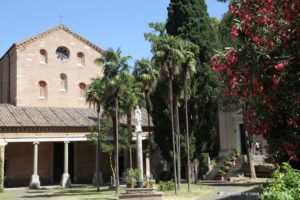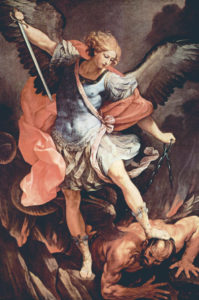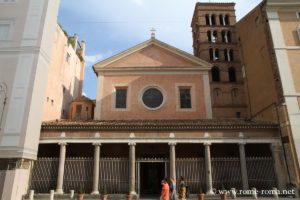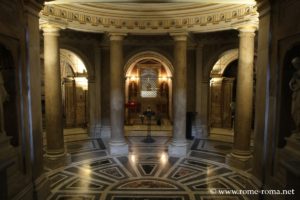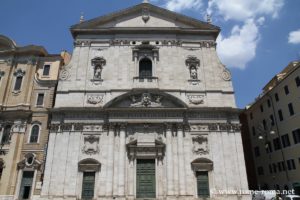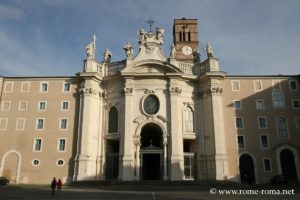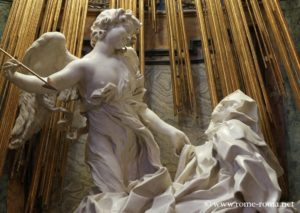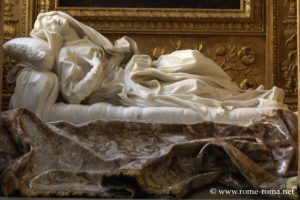After the four major basilicas previously described, here is a selection of ten churches among the many and sublime that the city has, then a top 40. If this list is so extensive it is because it is very difficult to talk about Rome leaving some aside, either because of their architecture, their remarkable history, or for the extraordinary masterpieces they can host.
First the 13 most beautiful churches, ordered according to our preference
1. Sistine Chapel, among the top churches
Located in the Papal Palaces of the Vatican, accessible via the Vatican Museums, the Sistine Chapel (Cappella Sistina) is a unique work in the world. The vault was painted by Michelangelo in the sixteenth century, with its sumptuous frescoes that illustrate the Genesis and episodes of the Old Testament. A few years later, the great artist created the huge fresco of the Last Judgment on the back wall, from 1535 to 1541.
These paintings have particular representations of human bodies, with the impression of movements, of impressive realism [page dedicated to the Sistine Chapel].
2. Basilica of Saint Clement in Rome
Saint Clement (San Clemente al Laterano) is a basilica and also one of the most beautiful illustrations of the architectural history of the last two millennia in Rome. The city has risen several meters over time, buildings being built on the oldest. Thus, this basilica has three superimposed levels. The lowest goes back to the Roman republic with a sanctuary dedicated to Mithras. Above was built a first early Christian church that preserves exceptional frescoes, especially from the eleventh century in a comic book style. On the last level is the current church. The latter preserves beautiful 12th-century mosaics and medieval elements, including the Schola cantorum and the cosmatesque pavement.
3. Basilica of Santa Maria del Popolo in Rome
The Parish Basilica of Santa Maria del Popolo (Saint Mary of the People in English) is certainly one of the most important testimonies of the Roman Renaissance. It is a true museum of this period, on the one hand because of its architectural features, and on the other hand for the many masterpieces of paintings and sculptures.
Thus, the Chigi Chapel was designed by Raphael and Bernini finished it with statues like Daniel and the Lion. Two remarkable paintings by Caravaggio can be found in the Cesari Chapel: Crucifixion of Saint Peter and the Conversion of Saint Paul. The Chapel of the Nativity from the end of the 15th century is decorated with Pinturicchio frescoes about the life of Saint Jerome. The same artist painted frescoes on the Virgin in the Basso della Rovere Chapel.
4. Basilica of Santa Maria in Trastevere
Marked by a Byzantine style, the basilica of Santa Maria in Trastevere dates from the 12th century, built on a 3rd century AD sanctuary in the heart of the Trastevere district. It is marked in particular by Romanesque and medieval art, with a bell tower of the twelfth or a beautiful mosaic frieze in front of the thirteenth century. Crossing its beautiful central nave framed by Ionic columns and paved with a cosmatesque pavement, under the remarkable coffered ceiling, we approach with wonder the choir and its beautiful mosaics of Byzantine style of the twelfth and thirteenth with its characters in perspective.
5. Basilica of Saint Sabina in Rome
Located on the pleasant and relaxing Aventine Hill, the Basilica of Santa Sabina is perhaps the most beautiful among the early Christian churches that survived in Rome. Built at the beginning of the 5th century, it is the seat of the Curia of the Order of Preachers Brothers (Dominican). Its vast interior is graceful with beautiful proportions.
The “orange garden” behind offers one of the most beautiful views of Rome with the Saint Peter’s Dome.
6. Basilica of Saint Praxedes in Rome
The Basilica of Saint Praxedes (basilica di Santa Prassede) now hidden between the houses of the district dates back to the 9th century. It is remarkable as one of the most beautiful expressions of the Byzantine style in Rome, with its rich and colorful mosaics of extraordinary quality and expressiveness. They are found in the apse, choir and triumphal arch on the one hand, and on the other in the extraordinary oratory of San Zenone. It also retains a beautiful cosmatesque paving.
7. Saint Agnes outside the walls in Rome
The complex of Saint Agnes Outside the Walls (Sant’Agnese fuori le mura) in Rome, located on Via Nomentana, is strongly marked by early Christian and medieval remains. The site includes the Catacombs of Saint Agnes, the Basilica of Constantine of the 4th century of which only the walls remain, the circular mausoleum of Saint Constance whose vaults bear remarkable frescoes of the 4th century ADC., and the 7th century Basilica of Honorius which is the current church. This one is very beautiful, with its two levels, its columns and Roman capitals, or the particular mosaics of the 7th in the apse.
8. Basilica of Saint Lawrence outside the walls
One of the seven churches of the pilgrimage of Rome, the Basilica of St Lawrence outside the walls (Basilica di San Lorenzo fuori le mura) is also one of the most suggestive churches of the beginnings of Christianity. It merged two separate churches, one from the 6th century, the other from the 13th century. Rebuilt after the war, it has however a lot of character with ancient columns, elements of the 6th century, its raised choir with elements of the 12th, its beautiful cosmatesque pavement, the cloister and its catacombs.
9. Basilica of Saint Mary in Cosmedin in Rome
On the Piazza della Boccà della Verità, the Basilica of Saint Mary in Cosmedin (Santa Maria in Cosmedin) from the 6th-7th centuries is one of the finest examples of medieval architecture and art in Rome. It keeps remains of ancient temples, including columns, and especially many elements of its reconstruction of the twelfth century, including the superb bell tower, the cosmatesque pavement, mosaics of the eighth, etc.
Under its porch is the famous Mouth of Truth (Bocca della Verità), a Roman sewer mouth with a human face whose legend says that the mouth would eat the hand of the one who would place it while pronouncing a lie.
Saint Mary in Cosmedin Interior of Saint Mary in Cosmedin Mouth of the True
10. Basilica of Saint Augustine in Rome
One of the first churches built in the Renaissance at the end of the 15th century, the Basilica of Saint Augustine in Camp Martius (Basilica di Sant’Agostino in Campo Marzio) has a beautiful interior, including masterpieces: the Madonna of the Pilgrims of Caravaggio or a fresco by Raphael of the Prophet Isaiah above a statue of Saint Anne and the Madonna and Child with Saint Anne of Sansovino.
11. Basilica of Saint Mary of the Altar in Heaven
Located on the Capitoline Hill, the Basilica of Saint Mary of the Altar in Heaven (Santa Maria in Ara Coeli) is one of the most fascinating churches in the center of Rome, rebuilt in the fourteenth century, with its many tombstones and works dating from the thirteenth to the eighteenth century. The Bufalini Chapel is decorated with remarkable frescoes from the Pinturicchio of the late 15th century illustrating the life of Saint Bernardine of Siena.
12. Church of Saint Louis of the French in Rome
The Church of Saint Louis of the French (San Luigi dei Francesi) is a baroque jewel in the center of Rome and the French national church of the city. It collects many testimonies of the history of France, and especially in a chapel three paintings of Caravaggio dedicated to the history of Saint-Matthew, as well as frescoes of Domenichino.
13. Saint Peter in Chains in Rome
Saint Peter in Chains (San Pietro in Vincoli) on Esquilin Hill is known above all for hosting the Moses of Michelangelo, a remarkable masterpiece of the master, in the Mausoleum of Julius II and the chains of Saint Peter which are exposed at the foot of the altar.
Map of churches
If you see this after your page is loaded completely, leafletJS files are missing.
The 39 most beautiful churches in Rome
Following our selection of churches in Rome concocted with relative faith but much love …
14. Saint Cecilia of Trastevere
Dating back to the 9th century, the church of Saint Cecilia of Trastevere (Santa Cecilia in Trastevere) houses the relics of Santa Cecilia and a magnificent sculpture of it. It is also of great tranquil place, preceded by a beautiful courtyard, located in a quiet area of Trastevere. It keeps cosmatesque pavings of the Middle Ages, the mosaic of the apse of the ninth century, the canopy of the twelfth. The interior remodelled in the 19th century included many antique elements.
15. Saint Ignatius of Loyola in Rome
The second Jesuit church of the order dedicated to its founder Saint Ignatius of Loyola (Sant’Ignazio di Loyola) was built in the 17th century. Particularly baroque, it is remarkable for its frescoes in perspectives by Andrea Pozzo whose famous trompe l’oeil dome.
16. Church of the Gesù in Rome
The remarkable baroque Church of the Most Holy Name of Jesus, called Church of the Gesù (Chiesa del Gesù), is the mother church of the Jesuits, built in the sixteenth century at the initiative of Saint Ignatius of Loyola. It is the model on which the churches of the order were built. It is one of the most beautiful churches in the center of Rome with its rich decorations, including its grandiose trompe l’oeil frescoes covering the vault of the Triumph of the Name of Jesus of the seventeenth century.
16bis. Church Sant’Andrea della Valle in Rome
The church of Sant’Andrea della Valle is a baroque church located on Corso Vittorio Emanuele II. Built from 1591, it is known for its large dome, the second highest in the city after that of Saint-Pierre. The interior is decorated with spectacular frescoes, notably on the vaulted ceiling painted by Domenichino and on the cupola decorated by Giovanni Lanfranco. It houses the tombs of two popes from the Piccolomini family.
17. Tempietto del Bramante
Located today in the cloister within the Spanish Academy, the Tempietto of San Pietro in Montorio, Tempietto del Bramante, is a small circular temple built by Bramante in the early 16th century. It is considered a masterpiece of the Renaissance thanks to its harmonious proportions.
18. Basilica of St. Mary of the Angels in Rome
The Basilica of Saint Mary of the Angels and of the Martyrs (Santa Maria degli Angeli e dei Martiri) is a remarkable church that has the particularity of occupying a part of the immense Baths of Diocletian of the Roman era. So the interior is grandiose, arranged in the sixteenth century with a conception of Michelangelo, and richly decorated in the seventeenth century with immense columns in red granite.
19. Santa Maria della Pace in Rome
The small church of Santa Maria della Pace is a major Baroque work in Rome, near Piazza Navona. It is remarkable for its exterior architecture, the friendly Bramante Cloister where one can have a coffee in peace. The famous Sibyls and Prophets frescos was painted by Raphael in the Chigi chapel. The Ponzetti Chapel preserves the Renaissance frescoes by Baldassarre Peruzzi.
20. Basilica of the Four Holy Crowned Ones in Rome
This ancient church on the slopes of the Caelius is dedicated to the Four Crowned Martyrs, four martyred Roman soldiers. The Basilica of the Four Holy Crowned Ones (Santi Quattro Coronati) has retained much of its medieval character, including its fortified walls and courtyards, beautiful granite columns, the 12th century cloister or the beautiful 13th century frescoes of the Oratory of San Silvestre with history on the legend of Constantine.
21. Basilica of St. Stephen in the Round in Rome
Very old church dating back to the 5th century, St. Stephen in the Round on the Caelian Hill (Santo Stefano Rotondo), is located on the Caelius hill. It is also one of the first circular churches in Italy, restored in the 15th century. It has medieval elements including the beautiful interior colonnade and contrasts with the interior wall which was entirely covered in the sixteenth century with «raw» scenes of Christian martyrs.
22. Basilica of Saint Mark the Evangelist in Rome
The Basilica of Saint Mark the Evangelist (San Marco Evangelista al Campidoglio) dates back to the 4th century and displays many architectural aspects. It has kept its old form, a bell tower of the twelfth century, a loggia in front of Renaissance style, ornaments of antique and medieval marble, and a strongly baroque interior of the eighteenth century but whose mosaic of the apse dates from the ninth century. Its wooden ceiling is the only one in Rome that dates from the 15th century.
Against the church, the Madama Lucrezia is one of the “talking statues” of Rome.
23. Basilica of Saints John and Paul in Rome
On the Caelius hill above Roman houses, the Basilica of Saints John and Paul on the Caelian Hill (Basilica dei Santi Giovanni e Paolo al Celio) is very old and preserves beautiful remains of the twelfth and thirteenth centuries, including the large bell tower or the Ionic portico. The inner nave is lined with ancient columns. At its base are the remains of foundations of the grandiose Temple of Claudius. The interior decoration is baroque.
24. Church of Saint Charles at the Four Fountains
The church of Saint Charles at the Four Fountains (San Carlo alle Quattro Fontane) is a masterpiece by Francesco Borromini, with the architect’s own style, complex and rational, including alternations of concavity and convexity in the facade and interior. It is elliptical like its neighbor made by Bernini (the “rival” of Borromini), whose beautiful dome with caissons with its geometric patterns. The very small cloister is also very original.
25. Church of Saint Andrew on the Quirinal
The Church of Saint Andrew on the Quirinal (Sant’Andrea al Quirinale) is a Jesuit church, designed by Bernini in the seventeenth century and considered one of the masterpieces of baroque art. The façade is preceded by two concave wings and the particularly refined nave is elliptical, as is its dome.
26. Saint Mary above Minerva in Rome
Close to the Pantheon, facing the Piazza della Minerva square occupied by a strange and elegant elephant sculpted by Bernini and bearing an Egyptian obelisk, the Basilica of Saint Mary above Minerva (Basilica di Santa Maria sopra Minerva) is the only church in Rome really gothic, although the Romanesque facade leaves no hint. Very beautiful in its forms, it houses among others a Christ risen from the cross of Michelangelo. Its Carafa Chapel is decorated with wonderful frescoes by Filippino Lipipi, emblematic of the early Renaissance.
27. Basilica of Saint Chrysogonus in Rome
Little frequented and yet remarkable, the Basilica of Saint Chrysogonus (Basilica di San Crisogono), which was the church of the Corsicans in Rome, is located on Viale Trastevere. Very old church dating back to the 4th century AD, it was rebuilt in the 12th century, then in the 17th. Thus the façade is baroque, the bell tower is Romanesque (XII). The interior has a cosmatesque pavement and was redesigned with antique columns. In the underground one discovers substantial remains and almost in their juice of the first church.
28. Basilica of San Saba in Rome
On the Little Aventine hill between the Aventine and the Caelius hills, the Basilica of San Saba is a pretty church of early Christian origin, located away from the Roman agitation. It preserves testimonies of its past, including beautiful elements of the Middle Ages.
29. Basilica of Saint Nicholas in Prison
The astonishing church of Basilica of Saint Nicholas in Prison (Basilica di San Nicola in Carcere), built around the 6th century A.D. is based on the remains of three ancient temples of a Roman forum whose colonnades can be seen in the walls or on the catwalks in the underground.
30. Basilica of Saints Sylvester and Martin in Rome
The Basilica of Saints Sylvester and Martin on the Mountains (Basilica di Santi Silvestro e Martino ai Monti), very old, preserves in its crypt the remains of a Roman house where the Christians met, a titulus, with a mosaic of the sixth century. Rebuilt in the 9th and 17th centuries, the main nave is separated from 24 ancient columns from the old basilica.
31. Three Fountains Abbey in Rome
Located outside the centre of Rome, the Three Fountains Abbey (Abbazia delle Tre Fontane) is the only Trappist abbey in the city. It has three main churches, including the Romanesque Cistercian abbey which has kept its 12th century structure almost intact.
32. Our Lady of the Conception of the Capuchins
The main attraction of the church of the Capuchins (Santa Maria della Concezione dei Cappuccini) of the seventeenth century is the ossuary of the crypt (paid access), with the bones of nearly 4,000 Capuchin monks, including mummified bodies.
33. Basilica of St. Lawrence in Lucina
The very old Basilica of St. Lawrence in Lucina (San Lorenzo in Lucina) dates back to the 4th century AD, rebuilt in the 12th century and whose interior was transformed in the 17th. It’s an interesting monument. It has beautiful medieval elements with antique material, a Romanesque campanile, a Crucifixion by Guido Reni inside or works by Bernini.
34. Church of the Twelve Holy Apostles in Rome
Of Byzantine origin, the Church of the Twelve Holy Apostles (Santi XII Apostoli) has a superb porch of the late fifteenth century with the statues of the twelve apostles. The interior is divided by large Corinthian pillars, and especially the fresco of the vault with the Triumph of the Franciscan Order by Baciccio in the early eighteenth and the Tomb of Clement XIV by Canova of the eighteenth.
35. Chiesa Nuova or Santa Maria in Vallicella
The church Santa Maria in Vallicella (Chiesa Nuova) of the sixteenth-seventeenth centuries, is a beautiful baroque church with a grandiose interior, marble chapels, frescoes by Pietro da Cortona and many works of art. Next door is the Philippine Oratory.
36. Basilica of the Holy Cross in Jerusalem in Rome
The Basilica of the Holy Cross in Jerusalem in Rome (Basilica di Santa Croce in Gerusalemme) is one of the seven churches of the Christian pilgrimage, which dates from Helena the mother of Constantine who brought here from the land from the Mount of Calvary in the Holy Land, as well as pieces of the Cross of the Holy Land. It has a famous Chapel of Relics.
37. Saint John the Baptist Beheaded in Rome
Built in the 15th century, the Church of Saint John the Baptist Beheaded (San Giovanni Battista Decollato) keeps frescoes by late 16th century Tuscan artists, polychrome marbles, and especially the oratory with a splendid 16th century pictorial cycle illustrating the life of Saint John the Baptist (Visitable on reservation or June 24)
38. Saint Mary of Victory in Rome
The Baroque Church of Saint Mary of Victory (Santa Maria della Vittoria), rebuilt at the beginning of the 17th century by Carlo Maderno, is interesting for its baroque qualities and above all The Ecstasy of Saint Teresa sculpted by Bernini in the mid-17th century.
39. San Francesco a Ripa in Rome
The Church of Saint Francis of Assisi by the River (San Francesco di Assisi a Ripa Grande), largely rebuilt in the 17th century, houses the Ecstasy of Blessed Ludovica Albertoni sculpted by Bernini as in the previous church.
More informations
- On Turismoroma city website : churches and basilicas in Rome, Christian Rome itineraries







